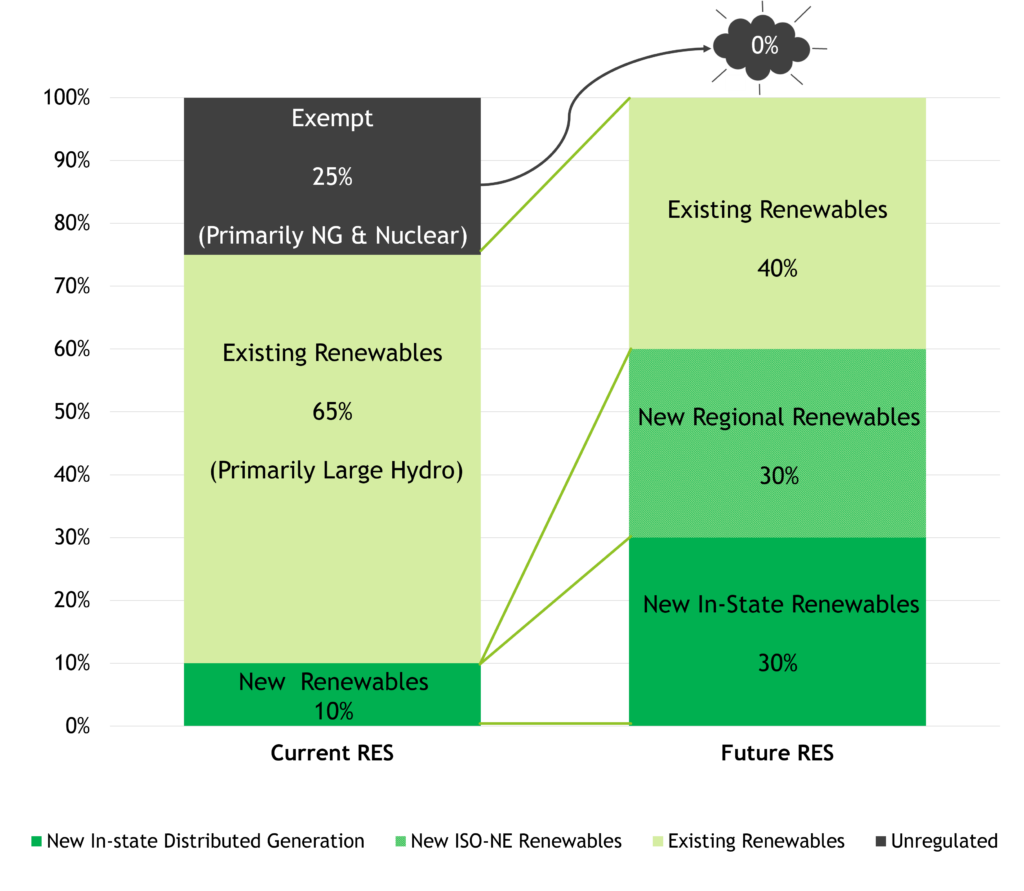The short answer is, don’t count on it.
Just as we are asking Vermonters to electrify everything, demand for renewables is increasing rapidly throughout the northeast, creating intense competition for renewable electricity. This fundamental problem is summarized succinctly in Green Mountain Power’s most recent Integrated Resource Plan – the roadmap for the utility’s investments for the next five years:
“It is not clear what volume of renewable energy supply will be available on a short-term basis in the future, especially with increasing competition for existing renewable resources in the region. ” – Green Mountain Power, 2021
Looking at the price and availability of power from offshore wind, out-of-state wind, and large hydropower, it is clear that while all of these resources will have a role to play in our energy future, putting all of our eggs in these baskets would be a mistake. A robust requirement for in-state renewable energy from distributed sources will help ensure that Vermont utilities can access cost-competitive, new renewable energy.
Offshore Wind
Several Vermont utilities cite off-shore wind as a significant future source of renewable energy. While the high power output from these projects makes offshore wind appealing, offshore wind has been slow and costly to build. Vermont utilities and regional regulators suggest that offshore wind availability will be very limited until the 2030s.
“No relevant amount of [offshore wind] from the New England leasehold can be interconnected until transmission issues have been resolved. One near-term step will be the issuance of a request for information (RFI) from developers and transmission providers for the best solutions… [that] would provide state planners the ability to prepare an RFP to design and develop the needed transmission solutions in the 2030-2035 timeframe.” – Connecticut Department of Energy and Environmental Protection
“Over the next several years we anticipate that there will be additional procurements efforts that GMP could participate in that could lead to acquiring entitlements for portions of larger projects that will come online late this decade or early next decade.” – GMP 2021 IRP
Offshore wind prices have been highly volatile ranging from approximately 6 – 13 ¢/kWh for power purchase agreements signed within the past 5 years. The details of most power purchase agreements (PPA) are not publically available, but the Vinyard Wind PPA with MA DOE is and it starts at 7.4 ¢/kWh and escalates to 12¢/kWh by 2041. By comparison, the price for a Standard Offer solar project in Vermont is in the range of 8.5 – 9 ¢/kWh and is fixed for a twenty-year term.
Large Hydro Power
Purchasing additional power from existing renewable facilities is a zero-sum game that simply reduces the power that can be used by another jurisdiction and does not change the generating mix of emissions at a regional level. This simple fact was one reason that the state of New Hampshire’s Site Evaluation Committee’s rejected the Northern Pass Transmission Project, stating, “[N]o actual greenhouse gas emission reductions would be realized if no new source of hydropower is introduced and the power delivered by the Project to New England is simply diverted from Ontario or New York.”
Onshore Wind
At approximately 4¢/kWh, onshore wind is one of the lowest-cost sources of electricity in the region but relatively few projects are in development, limiting the ability of Vermont utilities to increase the share of onshore wind in their portfolios. In the past 5 years, just two onshore wind projects have come online in New England and only six additional projects are currently proposed in the ISO-NE Interconnection Queue. Generally, only about half of the projects in the interconnection queue make it through the development process, and the majority of the power from the most significant of these projects, King Pine Wind in Aroostook County Maine, has already been contracted for by Maine and Massachusetts distribution utilities.

The Take Away
Betting entirely on out-state renewables would be bad policy. It’s a bet on resources that aren’t yet available (offshore wind), that aren’t being planned at scale (onshore wind), or that don’t really advance our climate goals (existing large hydro). This is why the Renewable Energy Standard reform supported by REV and a broad coalition of environmental groups advocates f
or a balanced approach, with up to 40% of our power coming from existing renewable resources like hydro, 30% coming from new renewable built anywhere in New England, and 30% coming from renewable projects in Vermont. It’s a proposal that balances environmental justice, economic development, and uncertainties about the price and availability of different renewable resources. It’s a proposal that protects Vermonters and our climate.
